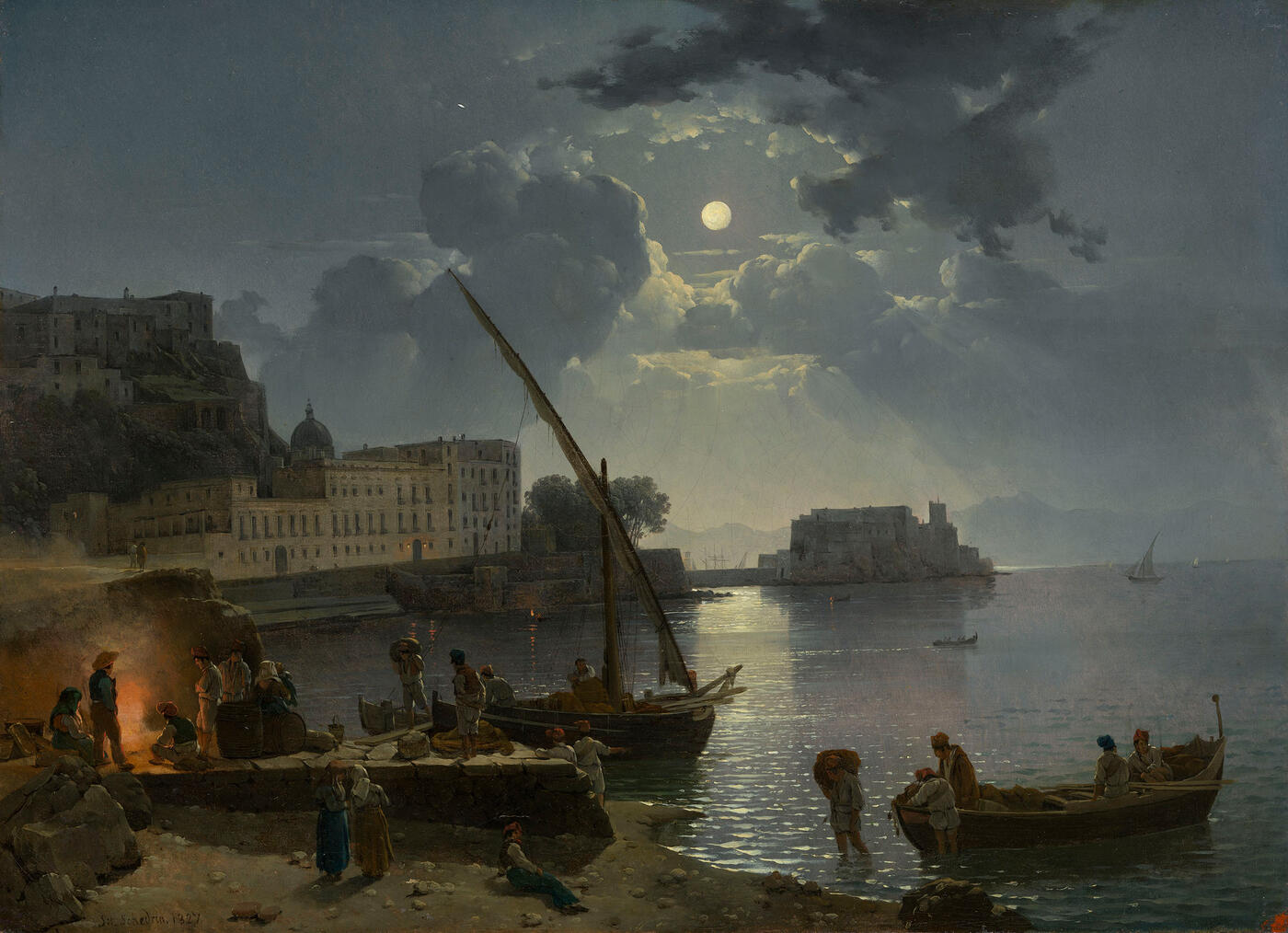28 Nov 2018 Important Russian Art Auctions, at Asia House
28 November 2018

21. SCHEDRIN, SILVESTR (1791–1830)
Moonlight over Naples, signed and dated 1827.
Oil on canvas, 43.5 by 60 cm.
Sold for 630,500 GBP
Provenance: Private collection, Europe.
Authenticity of the work has been confirmed by the expert V. Petrov.
Authenticity has also been confirmed by the expert S. Podstanitsky.
Moonlight over Naples is one of Silvester Schedrin’s most captivating Italian images. As happened with many of his best works, the artist constantly produced variations of it and, over the course of several years, created a whole series of charming nocturnes of the Bay of Naples. Today, at least four versions of this composition are known, painted between 1827 and 1829 and kept in the collections of the largest art museums in Russia — the State Tretyakov Gallery, the State Russian Museum, the Ivanovo Regional Art Museum and the Tambov Regional Art Gallery. The landscape presented for auction is the earliest, most luminous and most lyrical in the series. It is dated 1827, the time when the artist’s skill reaches its peak and his favourite motifs are still the picturesque harbours and grottoes that embellish the Amalfi and Neapolitan coasts and the offshore islands. Although repeatedly depicting the same view at the request of his customers, Schedrin would each time create an original picture as he perfected his method of working from life. That is why, despite the artist’s unchanging viewing perspective, selected once and for all, which opens up from the Santa Lucia Embankment onto the Villa Partenone, the Pizzofalcone Hill, the dome of the Church of San Francesco and the Castel dell’Ovo, a fortress looming motionless like an inaccessible island, the night landscapes differ not only in the details of the composition, but also in particular aspects of the colour scheme. Evidently, in each version of the picture, Schedrin painted the sky and the water from life — but at different hours — trying to convey the fleeting, elusive effects of the moonlight and the movement of the air, as well as the perspective view.
By depicting the Bay of Naples on the canvas just one hour before dawn, the artist not only combines two sources of illumination — the ghostly light of the moon, surrounded by swirling clouds, and the bright yellowish-orange light of a campfire lit by fishermen on the shore — but he also covers the calm surface of the water, gleaming silvery in the moonlight, with delicate, slightly pinkish overtones from the sun rising beyond the edge of the canvas. This effect lends a particular elegance to the picture’s range of colours, while the contrast between warm and cold tones heightens the expression of the prevailing mood.
It is most intriguing to compare this landscape with other pictures in the series, where over time the colouring gradually thickens, the pre-dawn haze gives way to a night mist enveloping the buildings, and the viewer is confronted by an image that is dramatic rather than lyrical, evoking associations with romantic stories about the lives of smugglers and the noble Carbonari in the recent Neapolitan revolution. It comes as no surprise that the image of Naples by night created by the artist proved to be well attuned to the new, romantic age. By combining a majestic panoramic view with everyday life, Schedrin managed to convey on the canvas a sense of the continuity of the flow of life. Typically, not only the lighting and the mood of the landscape change from picture to picture, but also the genre scene of the fishermen’s lives depicted in it, the positioning of the figures around the fire and the work of the people in the boat that is coming in to moor. Schedrin generally enjoyed chatting to the locals, who willingly posed for him for a small reward, and he would constantly incorporate his genre sketches, “copied” from life, into his pictures, seeking to bond the natural- ness of life and the sublimity of the artistic ideal.
Even during Schedrin’s lifetime, his works had already begun to enjoy great success among collectors and lovers of the fine arts, including members of the Imperial Family and aristocratic customers. Nor did this fame diminish after the artist’s early death. Moreover, the combination of the tranquil harmony of his works and the untimely death of their creator endowed the image of the artist with additional romantic overtones in the eyes of his contemporaries. So, for example, a review of the 1836 St Petersburg Academy of Arts exhibition, at which the artist’s Neapolitan views were presented to the Russian public, declared: “The charming Schedrin, who with such sweetness and faithfulness has painted for us the environs of Naples, which, according to the Italian proverb, allows anyone lucky enough to see its heavenly beauty to die peacefully” (“Exhibition at the Academy of Arts”, in Khudozhestvennaya gazeta, December 1836, Nos. 11 and 12, p.177).
The provenance of Schedrin’s Moonlight over Naples, now to be auctioned, is also very noteworthy. It comes from an old European collection and enables one more work of rare artistic quality to be added to the illustrious cycle of Naples nocturnes executed in the final years of Silvester Schedrin’s life.
Notes on symbols:
* Indicates 5% Import Duty Charge applies.
Ω Indicates 20% Import Duty Charge applies.
§ Indicates Artist's Resale Right applies.
† Indicates Standard VAT scheme applies, and the rate of 20% VAT will be charged on both hammer price and premium.